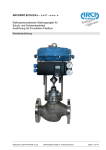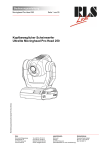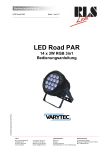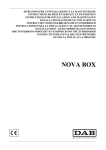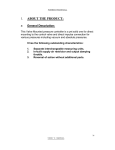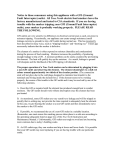Download Operating Instructions Pressure Controller Type „ROBOTER“
Transcript
Operating Instructions Pressure Controller Type „ROBOTER“ 1. Function 1.1 By the connection Z the controller is provided with air supply (free of dust, oil and water) of a constant pressure of 1,4 bar (max. 2,0 bar). The connection Y is for the actuator, diaphragm control valve, or the like. The supply air blows on a nozzle-flapper-system which is mounted to a lever. The constant-restrictor in the air supply line measures the air quantity out so that with open nozzle the adjustable pressure at connection Y goes towards zero bar and with closed nozzle towards 1,0 bar (max. 2,0 bar). 1.2 At the other end of the lever an adjustable reset spring is fastened. It increases or decreases the feedback force in accordance with the lift position of the valve (with increasing force the control circuit becomes lazier). A setpoint spring secures the lever in its bearing. The bellows assembly consists of the bellows and a pressure bolt, which are connected. If the pressure on the bellows increases, the lever rises; if the pressure on the bellows decreases, the lever inclines. 1.3 With the design „increasing/increasing“ on increasing pressure the lever is pushed upwards by the bellows so that air is stowed between nozzle and flapper. As a result the pressure Y increases. 1.4 With the design „increasing/decreasing“ the lever is pushed upwards by the bellows on increasing pressure so that air escapes between nozzle and flapper and the output pressure Y drops. 1.5 A change of the setpoint value is effected by more or less biasing the setpoint spring. In the output Y of the pressure controller is a damping throttle which has to be adjusted once at the service place and by which the control speed of the actuator can be influenced in case of a slight tendency to vibration of the control circuit. 2. Start-up 2.1 The pressure controller is mounted to the actuator at the works. Regarded in flow direction, the connection for the impulse line has to be arranged with the overflow plant before the control valve, with the reducing plant after the control valve. The impulse line has to be laid in such way that condensate (with medium steam) can develop before the bellows, e.g. by U-shaped or trumpet-shaped arrangement. A shut-off device (valve or slide) has to be provided so that an exchange of defective bellows is possible without stopping the whole plant. 2.2 With the basic adjustment of the controller -especially after exchange of bellows- it has to be observed that the pressure screw part 29 always engages accurately in the counter bearing of the measuring bellows part 35. For this purpose the pressure screw has to be screwed into an extent that the bellows are biased by approx. 1,5 mm, and then it has to be countered with the nut part 31. Code: 902BVE.DOC Date of issue: 23. January 2001 902-BVe ARCA-Regler GmbH D - 47918 Tönisvorst Page 1 of 2 Operating Instructions Pressure Controller Type „ROBOTER“ 2.3 On the start-up the required air supply Z of minimum 1,4 bar (max. 2 bar) is adjusted at the air pressure reducer. The air supply should be by approx. 0,2 bar higher than the max. operating pressure of the connected actuator (see name-plate: control range). 2.4 After the adjustment of the controller it has to be checked, if the control equipment runs through the whole range (e.g. lift of a control valve). If the required output pressure is not achieved, the following has to be examined: a) the air connections as regards leakage points b) the constant-throttle with regard to soiling After start-up or longer standstill the impulse chamber part 37 has to be air-vented by screw part 39. 3. Service instructions 3.1 As a complete control station, the pressure controller in connection with a control valve is independent of an outside service; only on air failure or breakage of the actuating diaphragm the valve must be operated by the hand adjustment device. 3.2 If set value and actual value of the pressure in balanced condition of a control circuit do not coincide, by means of the setpoint spring the pressure can be increased by turning clockwise and decreased by turning counter-clockwise. A change of the proportionality of the controller is achieved by adjustment of the reset spring. A diminution of the active turns results in a greater P-range and vice versa. 3.3 In case that still then the controller is restless, by turning-in the damping throttle (part 16) the control pressure “Y” to diaphragm chamber can be damped (approx. 2.5 revolutions max.). 4. Maintenance At bigger intervals (depending on the air quality) the constant restrictor should be taken off and cleaned by experienced personnel e.g. precision mechanics. Code: 902BVE.DOC Date of issue: 23. January 2001 902-BVe ARCA-Regler GmbH D - 47918 Tönisvorst Page 2 of 2




